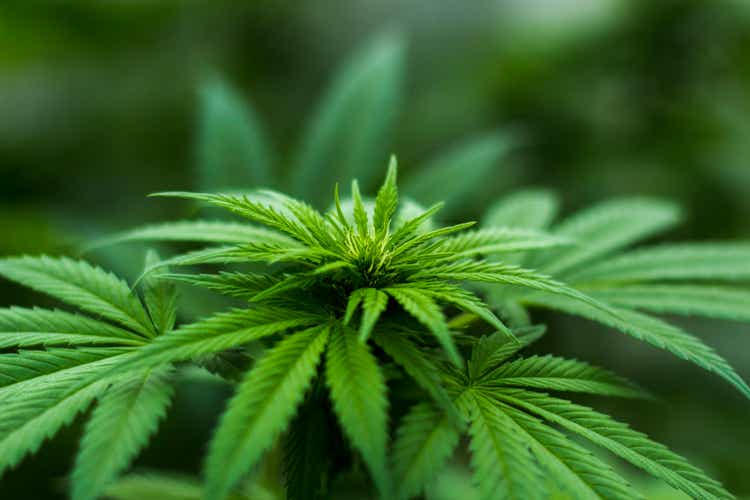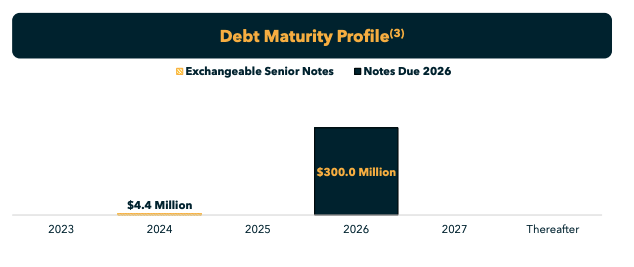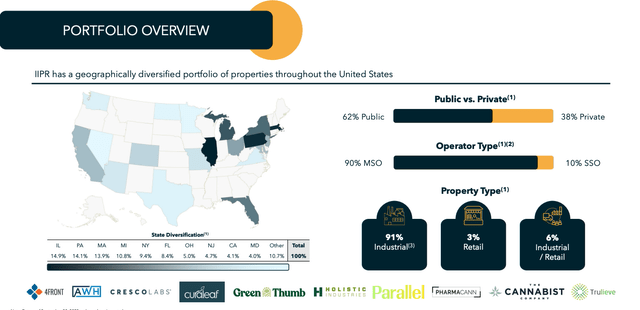Michael Fischer
Dear readers,
I became quite interested in cannabis REITs last year when their price plummeted as a result of the perfect storm of bad news. A shift in sentiment put the industry largely out of favor and resulted in many operators/tenants struggling to pay rent. Moreover, high interest rates and a tight credit market has made it much more difficult for operators to get financing and has pushed cannabis stock valuations to record low levels. As a result, many of these stocks reached double-digit dividend yields and, in my opinion, became attractive investment options with significant upside potential and a number of positive catalysts just around the corner.
I’ve been covering my favorite cannabis REIT – NewLake Capital Partners (OTCQX:NLCP) for a while and the stock has increased by close to 50% since my first BUY recommendation published in June 2023.
Today I want to start coverage NLCP’s close peer – Innovative Industrial Properties (NYSE:IIPR) which shares a lot of the same (positive) characteristics.
Portfolio and tenants
IIPR owns a portfolio of 108 triple-net lease properties in 19 (primarily license-limited) states where the license is generally tied to the property. The vast majority (91%) of properties are industrial cultivation facilities, and only 3% are pure retail properties.
The REIT has 29 tenants with a long average remaining lease term of nearly 15 years and leases to some of the biggest cannabis players, many of which are publicly traded. IIPR’s largest tenant PharmaCann accounts for 16% of ABR, followed by Ascend Wellness (OTCQX:AAWH) at 11% and Green Thumb Industries at 7.6% (OTCQX:GTBIF). Similarly to its peers, the REIT has a high tenant concentration with top 10 tenants accounting for 77% of ABR.
High tenant concentration can be risky, especially at a time when some tenants are already having trouble paying rent. Last year, IIPR has already taken possession of some properties previously leased to Green Peak. In particular the Summit building – a cultivation and processing facility under redevelopment, and three small retail locations worth less than $3 Million. Green Peak continues to pay rent on the remaining properties and management has stated in their Q3 earnings call that they already have an LOI to re-lease the Summit property to a new tenant.
Moreover, IIPR has also taken actions against its second troubled tenant Parallel (10th biggest tenant) and regained possession of one property in Texas and one in Pennsylvania. Parallel continues to pay rent on the remaining properties, but there is no plan so far for the foreclosed assets.
Finally, in Q3, the remaining four properties previously leased to King’s Garden were also foreclosed on. Two of these (19th Avenue and McLane) were already under an LOI for re-lease less than a month after taking possession, with the remaining two properties that represent less than 1% of the portfolio still vacant.
IIPR has done a good job of working through tenant delinquencies and despite the troubles has reached solid rent collections of 97%.
With long leases, high occupancy and a great balance sheet (discussed later), the single biggest risk remains the tenant’s ability to pay rent. Luckily, there are several catalysts that should ease financial pressures on tenants and contribute to healthier rent coverage.
Catalysts
These catalysts are legislative in nature and there are three of them that I’m aware of. One that is likely to play-out in a matter of months, one that might take a year or two and one that’s more long-term.
First, there’s been extensive debate about rescheduling cannabis to a Schedule 3 substance (meaning a low risk drug). The U.S. Department of Health and Human Services responded to the president’s request back in August and now all eyes are on the DEA which has the final authority to approve the rescheduling. Recently, the DEA said that they are currently reviewing the request and the approval seems likely. It’s very likely that the DEA will finalize the review within a few months. This is the last formal step in the approval process and if approved, cannabis will be rescheduled to Schedule 3. Potentially within the first half of 2024. The change will benefit cannabis operators, i.e. IIPR’s tenants, tremendously by lowering their taxes and therefore improving their cash flow and ability to pay rent.
Second, a modified version of the SAFE Banking bill has recently passed through the Senate. The bill, which is now referred to as SAFER, would substantially lower banking requirement for cannabis operators and increase their ability to get access to reasonably priced capital. I personally think this would be an even bigger catalyst than the rescheduling, especially in light of the tight credit market which we currently have which has been crushing the industry. Unfortunately, it’s hard to say at this time whether the bill will be passed in time before elections.
Third, the cannabis industry filed a lawsuit against the Federal government, questioning whether or not government has the right to limit cannabis trade across state borders. While the outcome is unclear and will likely take years to play out, it could have vast implications for the industry in the long-term.
Financials
Similarly NLCP, IIPR has very low leverage for a REIT of only $300 Million, vs a market cap of $2.6 Billion and annual rent of $280 Million. This puts the REIT in a very healthy position. Their debt, which has a fixed rate of 5.50% is due in 2026 and will likely get refinanced at a lower rate by then.
IIPR Presentation
IIPR has recently raised their quarterly dividend to $1.82 per share, which correspond to a dividend yield of 7.7% with an 80% payout ratio, despite rent collections being somewhat down. While most net lease REITs tend to have a lower payout ratio, the fact that IIPR has an incredibly low debt with no maturities this and next year, gives it a lot of flexibility and extra safety. The only major risk to the company’s cash flow are tenant delinquencies, but with a 20% payout buffer, the margin of safety is significant and the dividend quite safe.
In addition to a solid dividend yield, there is some upside potential here.
The stock currently trades at a P/AFFO of just 10.4x and an implied cap rated of 8.3%.
With a 10-year yield of 4% today, that represents a 430 bps spread to long-term yields. Going forward, I expect valuation to be driven by interest rate expectations and long-term yields, but I also expect the spread to narrow to 3-3.5% once tenant delinquencies get resolves (say over the next two years), which would result in upside of about 15%.
Two years of dividend worth 15.4% + 15% upside = 30.4% return over two years. That’s enough for me to issue a BUY rating, especially for a REIT like IIPR which has little to no interest rate risk and is facing potential bullish catalysts.
Risks
No investment is without risk.
In the case of IIPR the biggest risk to their cash flow is rent collections. Though they remain relatively high at 97%, if sentiment towards the industry remains negative, tenants struggle to access capital and legislation takes longer to pass than expected, there is a risk that more tenants will default on their rent payments which would negatively impact the company’s payout ratio, as well as stock price.
Moreover, although IIPR has little debt, its valuation (unlike its cash flow) is closely tied to interest rates. That means that a prolonged period of high interest rates caused by the Fed pushing rate cuts further into the future, or a further increase in interest rate would have a negative impact on the stock price.





